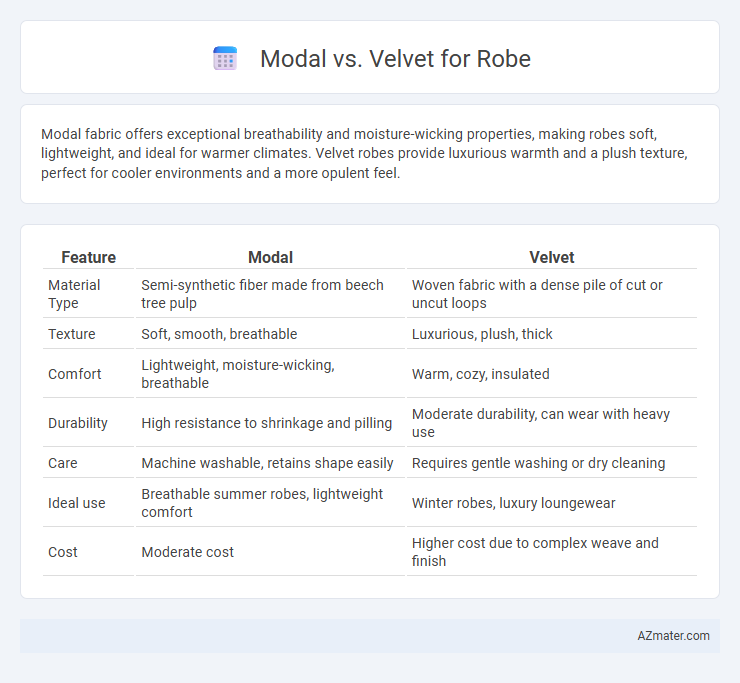Modal fabric offers exceptional breathability and moisture-wicking properties, making robes soft, lightweight, and ideal for warmer climates. Velvet robes provide luxurious warmth and a plush texture, perfect for cooler environments and a more opulent feel.
Table of Comparison
| Feature | Modal | Velvet |
|---|---|---|
| Material Type | Semi-synthetic fiber made from beech tree pulp | Woven fabric with a dense pile of cut or uncut loops |
| Texture | Soft, smooth, breathable | Luxurious, plush, thick |
| Comfort | Lightweight, moisture-wicking, breathable | Warm, cozy, insulated |
| Durability | High resistance to shrinkage and pilling | Moderate durability, can wear with heavy use |
| Care | Machine washable, retains shape easily | Requires gentle washing or dry cleaning |
| Ideal use | Breathable summer robes, lightweight comfort | Winter robes, luxury loungewear |
| Cost | Moderate cost | Higher cost due to complex weave and finish |
Introduction: Comparing Modal and Velvet for Robes
Modal robes offer exceptional softness and excellent breathability, making them ideal for comfortable, lightweight loungewear. Velvet robes provide a luxurious, plush texture with superior warmth and a rich appearance, perfect for elegant and cozy wear. Choosing between Modal and Velvet depends on preferences for breathability versus opulent warmth in robe materials.
Fabric Overview: What is Modal?
Modal fabric, derived from beech tree pulp, is a type of rayon known for its softness, breathability, and moisture-wicking properties, making it ideal for robes that offer comfort and durability. Its smooth texture and resistance to shrinking enhance the luxurious feel of modal robes compared to traditional cotton. Modal also maintains color vibrancy wash after wash, ensuring robes retain their rich appearance over time.
Fabric Overview: What is Velvet?
Velvet is a luxurious fabric known for its dense pile of evenly cut fibers that create a soft, plush texture with a rich sheen, often made from silk, cotton, or synthetic fibers. Compared to modal, which is a smooth, breathable, and lightweight semi-synthetic fabric derived from beech tree pulp, velvet provides a heavier, warmer, and more tactile experience ideal for robes intended for comfort and elegance. Velvet's unique weaving process and pile structure contribute to its distinctive depth and softness, making it a popular choice for robes that combine visual richness with cozy warmth.
Comfort and Feel: Modal vs Velvet
Modal fabric offers a lightweight, breathable feel with exceptional softness and moisture-wicking properties, making robes comfortable for warm and humid conditions. Velvet provides a plush, dense texture with a luxurious warmth and smooth surface, ideal for colder environments where coziness is a priority. Choosing between Modal and Velvet depends on whether you prefer a breathable, silky robe or a thick, velvety garment that retains heat.
Breathability and Temperature Regulation
Modal fabric offers excellent breathability and moisture-wicking properties, making it ideal for robes that keep you cool and dry. Velvet, while luxurious and soft, has lower breathability and tends to retain heat, which may cause warmth buildup during extended wear. For temperature regulation, modal robes provide better airflow and comfort, especially in warmer climates or throughout the day.
Durability and Care Requirements
Modal fabric offers superior durability compared to velvet, maintaining its softness and shape even after multiple washes. Velvet, while luxurious and plush, requires more delicate care to prevent crushing or damage to its pile, often needing dry cleaning or gentle hand washing. Modal robes are generally easier to care for, being machine washable and resistant to shrinking, making them a practical choice for long-term use.
Appearance and Texture Differences
Modal fabric offers a smooth, silky appearance with a subtle sheen that enhances the robe's elegance, while velvet provides a rich, plush texture with a deep, luxurious luster that makes it visually striking. Modal robes feel lightweight, breathable, and soft to the touch, making them ideal for comfort and everyday wear, whereas velvet robes deliver a thicker, warmer sensation with a dense pile that adds tactile richness. The lightweight, draping quality of modal contrasts with velvet's heavier, structured feel, impacting the robe's overall silhouette and movement.
Sustainability and Environmental Impact
Modal fabric, derived from beech tree pulp, uses less water and energy during production compared to conventional cotton, making it a more sustainable choice for robes. Velvet, often made from synthetic fibers like polyester or nylon, tends to have a higher environmental impact due to petrochemical processing and non-biodegradability. Choosing modal robes supports eco-friendly practices through biodegradable materials and lower carbon emissions, whereas velvet robes usually contribute more to pollution and landfill waste.
Price Comparison: Modal vs Velvet Robes
Modal robes typically offer a more affordable price point compared to velvet robes, making them a budget-friendly option for buyers seeking softness and breathability. Velvet robes, known for their luxurious feel and rich texture, generally come with a higher price tag, reflecting the premium fabric quality and heavier weight. Consumers prioritizing cost-effectiveness often choose modal, while those valuing opulence and warmth may invest more in velvet robes.
Choosing the Right Fabric: Which is Best for You?
Selecting between Modal and Velvet for a robe depends on your preference for softness, breathability, and warmth. Modal is a semi-synthetic fabric made from beech tree pulp, prized for its moisture-wicking, silky texture, and lightweight feel, making it ideal for year-round comfort. Velvet, known for its plush pile and luxurious appearance, provides superior warmth and a cozy, rich texture perfect for cooler climates or a more opulent look.

Infographic: Modal vs Velvet for Robe
 azmater.com
azmater.com